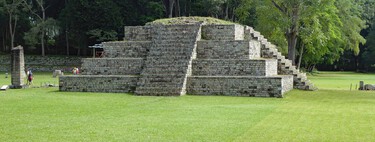We have been discovering the Mayans for over 500 years. Mexico is a real goldmine, and projects such as the controversial Mayan Train have demonstrated this. Archaeologists have found many vestiges of the past by exploring the layout of the railways (even a hidden 25-metre pyramid) and in other parts of the country archaeological remains from the pre-Hispanic era continue to appear.
Examples include the canals of Mexico City, the entrance to the underworld in Oaxaca, or the recent discovery of an archaeological site in an area that had not attracted much attention until now: Tecacahuaco. New technologies will also allow us to learn more about places that have already been studied, but today we are going to go back to when it all began: the discovery of the Mayan cities of Yucatan.
Juan Diaz and Tulum. As always happens in these cases, someone may have discovered it before, but if it is not documented, it is not worth much. In the discovery of the Mayan cities, there is much talk about the expedition of 1840, but was there really someone who, three centuries beforehas already written about these Mayan cities.
Juan Díaz was the chaplain and chronicler of Juan de Grijalva’s second expedition to the Mexican coast. He did not go into much detail, and at that time documenting the past was not an obsession (finding gold and silver, on the contrary, was), but Díaz wrote that he had seen a city at least “as big as Seville.” It is believed that this city was Tulum, a site very interesting today, but a few years after that sighting it was described as a simple city in ruins.
Stephens and Catherwood. Taking a leap in time, we find ourselves in the middle of the 19th century. John Lloyd Stephens He was a lawyer from New Jersey in his youth he went to Europe. He traveled through several countries and ended up visiting both Jordan and Egypt, touring the country’s main sites and documenting his journey.
When it was time to return home, on a stopover in London he met Frederick Catherwood, a British architect and painter who had already participated in some archaeological expeditions. Before traveling to Europe, Stephens was going to dedicate himself to politics and thanks to his contacts he managed to be appointed US Chargé d’affaires in Central America.


Drawing of Tulum by Catherwood
Buying a city for 50 dollarsStephens and Catherwood were interested in exploring the area and set out on their journey in 1839. The 1840s were not the best time to travel, as areas such as Copán were plagued by civil strife, but the pair set out on foot through the jungle and, after hacking their way through with machetes and almost despairing at finding nothing, their patience was rewarded.
They came across a carved stone slab that caught their attention, and little by little they found more things (other steles, stairs and ornate walls). Stephen considered the area to be of great archaeological value and I buy it to its owner for 50 dollars. It was then that they began to work on cleaning and documentation. Catherwood took charge of this due to his talents as a painter and architect.


Second expeditionCatherwood and Stephen published the report of that first expedition (Incidents of Travel in Central America, Chiapas and Yucatan) and the work drew attention to those magnificent lands of the Maya that had been forgotten by Spanish explorers. It was a difficult trip, but they achieved colossal success and, on a second expedition in 1941, the couple devoted themselves to continuing to study the cities of Tulum, Mayapan, Aké and Chichén Itzá.
The two colleagues maintained contact. Stephens had been named Vice President and Director of the Ocean Steam Navigation Company, but in 1850 he was offered the opportunity to supervise the construction of the Panama railroad. So, I offered Catherwood his position while he was busy with the trains. Two years later, however, he died and a plaque with Mayan hieroglyphics was placed on his tombstone.
Catherwood was not long in joining him, as he died in 1854, although in a more tragic way: while travelling from Liverpool to New York, the cruiser Arctic sank. All 385 passengers died and the press at the time paid no attention to the fact that he was one of them.


The Castle, Chichen Itza, by Maler
Teoberto Maler. The couple’s work was vital for other researchers and archaeologists to notice Yucatán, and one of them was Teobert Maler. Austro-German born in 1842, he was also an architect, but he wanted to see the world. That led him to enlist as a soldier in the army of Mexican Emperor Maximilian I. Republican forces ended his empire and Maler, instead of going into exile, stayed in Mexico.
He renamed himself Teoberto, as it was easier to pronounce, and because of his love of antiquities and photography, he set out on a journey to document Mayan ruins. Like Catherwood and Stephens before him, he made his way through the jungle, machete in hand and with the help of the natives, but as well as paper and pencil, he also had a camera.


This is how he managed to document the state of El Castillo de Chichén Itzá in 1892 or some tablets that he found along his way. He also realized that previous explorers had overlooked many ruins and documented only part of the richness of the place.
No shipping to Europe or the US. Furthermore, there was something that Maler did not like at all. When there was a sighting of something of some value, the tendency was to tear it from the spot and transport it to Europe or the United States. His opinion was that everything should be left in his place, preserved intact for his study. They were ideas ahead of his time (tell the British Museum) and he wrote several letters to the Mexican government exposing his thoughts.
And we might think that, after such an important job, Maler would live comfortably, but… no. The first thing is that his works were not successful and his scientific publications were difficult to compare because he sent them and then left for a few months to continue researching, which made it impossible to contact him. The second thing is that his money had disappeared and he made a living selling copies of your photographs to tourists and other archaeologists.
He died in 1817, at the age of 75, in Mérida and his works were published posthumously. Curiously, he died without knowing that he was one of the precursors of modern archaeology, but at least he left us with the impressive photo of El Castillo with the weeds covering the entire staircase to remember.
Images | Beyond My Ken, Frederick Catherwood, Teoberto Maler, Daniel Schwen
In Xataka | The Mayans played soccer. And now we know that under the fields they buried a hallucinogenic surprise













Add Comment